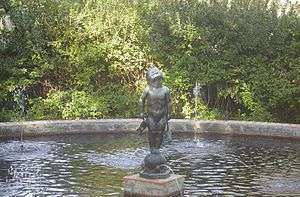Edith Barretto Stevens Parsons
Edith Barretto Stevens Parsons (1878 Houston, Virginia -1956 New Canaan, Connecticut) was an American sculptor.
Life

She studied with Daniel Chester French, and at the Art Students League of New York, where she won a sculpture prize and scholarships. She apprenticed with James Earle Fraser.[1]
She sculpted figures for the 1902 St. Louis Exposition's Liberal Arts Building, and in 1908 showed her sculpture Earth Mother at the National Academy of Design. That same year, she married Howard Crosby Parsons, and built a studio on the top floor of their home.
Her work changed its subject matter as her own children were born and posed for her sculptures, often holding ducks, turtles, and other creatures. Duck Baby, beginning a series of garden sculptures for which she is best known today, was the popular hit of the 1915 Panama-Pacific Exposition. The exposition handbook stated: "In the presence of so much that is weighty and powerful, the popularity of Duck Baby is a significant and touching indication of the world's hunger for what is cheerful and mirth-provoking."[2] The same may be said of Turtle Baby and Frog Baby, which forms the centerpiece of the small works collection at Brookgreen Gardens, South Carolina.
Parsons also created portrait busts and public monuments including a World War I memorial in Summit, New Jersey, and a fountain dedicated to John Galloway in Memphis, Tennessee.[2]
See also
References
- ↑ "Edith Barretto Parsons". Pelissier Galleries. Retrieved January 29, 2012.
- 1 2 Rubinstein, Charlotte Streifer (1990). American Women Sculptors: A History of Women Working in Three Dimensions. Boston: G.K. Hall & Co. ISBN 0-8161-8732-0.
External links
- "Edith Barretto Stevens Parsons ", Artnet
- "Edith Parsons Turtle Baby Fountain". Antiques Roadshow. July 16, 2005. Retrieved January 29, 2012.
- "Frog Baby (1917)". Pigtailsinprint. Retrieved January 29, 2012.
- "Parsons, Edith Barretto Stevens". Stanford Fine Art. Retrieved January 29, 2012.